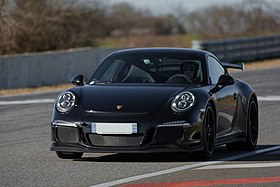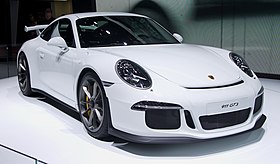Porsche 911 GT3
| Porsche 911 GT3 | |
|---|---|
 |
|
| Overview | |
| Manufacturer | Porsche |
| Production | 1999–present |
| Assembly | Stuttgart-Zuffenhausen, Germany |
| Body and chassis | |
| Class | Sports car |
| Body style | 2-door coupé |
| Layout | RR layout |
| Powertrain | |
| Engine | Flat-six engine |
| Transmission | 6-speed manual or 7-speed dual-clutch gearbox |
| 996 GT3 | |
|---|---|
 |
|
| Overview | |
| Production | 1999–2005 |
| Powertrain | |
| Engine | 3.6L 360 PS (265 kW) H6, 3.6 L 380 PS (279 kW) H6 |
| Dimensions | |
| Length | 174.6 in (4,435 mm) |
| Width | 69.7 in (1,770 mm) |
| Height | 50.2 in (1,275 mm) |
| 997 GT3 | |
|---|---|
 |
|
| Overview | |
| Production | 2006–2011 |
| Powertrain | |
| Engine | 3.6 L 415 PS (305 kW) H6 3.8 L 435 PS (320 kW) H6 3.8 L 450 PS (331 kW) H6 4.0 L 500 PS (368 kW) H6 |
| Dimensions | |
| Length | 174.3 in (4,427 mm) |
| Width | 71.2 in (1,808 mm) |
| Height | 50.4 in (1,280 mm) |
| 911 GT3 | |
|---|---|
 |
|
| Overview | |
| Production | 2013-present |
| Powertrain | |
| Engine | 3.8 L 475 PS (349 kW) H6 4.0 L 500 PS (368 kW) H6 |
| Dimensions | |
| Length | 178.94 in (4,545 mm) |
| Width | 72.91 in (1,852 mm) |
| Height | 49.96 in (1,269 mm) |
The Porsche 911 GT3 is a high performance version of the Porsche 911 sports car primarily intended for racing. It is a line of high-performance models, which began with the 1973 911 Carrera RS. The GT3 is named after the Fédération Internationale de l'Automobile (FIA) Group GT3 class in which it was designed to compete.
A number of variations, designed for road and track duty, have been introduced since its launch in 1999. More than 14,000 911 GT3 cars have been produced.
The GT3 has had a successful racing career in the one-make national Porsche Carrera Cup series, and the international Porsche Supercup. It has won championship and endurance races, including the GT class of the American Le Mans Series seven times, first overall in the 24 Hours of Daytona, and first overall at the 24 Hours Nürburgring six times.
The "GT3" nameplate was introduced in 1999 as part of the first generation of the Porsche 996 model range (commonly known as 996.1). As with Porsche's previous 911 RS models, the 996 GT3 was focused on racing, and so was devoid of items that added unnecessary weight to the car. Sound deadening was almost completely removed, as were the rear seats, rear loud speakers, sunroof, and air conditioning, although automatic air conditioning and CD/radio became no-cost optional add-ons.
The engine of the 996 GT3 set it apart from most of the other Porsche 996 models, although it shared the same basic design of the standard so-called "integrated dry sump" flat-six engine. The engine is naturally aspirated and based on the unit used in the Porsche 962 and Porsche 911 GT1 race cars. That engine was known as the 'Mezger' engine, after its designer Hans Mezger. The engine uses the original air-cooled 911's versatile dry-sump crankcase, with an external oil reservoir. The 996 GT3 has 360 PS (265 kW; 355 hp), compared to the 300 PS (221 kW; 296 hp) of the regular Porsche 996. In GT3 configuration, this so-called "split" crankcase (meaning the parting line of crankcase is on the crankshaft centreline) uses, instead of a fan and finned cylinders, separate water jackets added onto each side of the crankcase to cool banks of three cylinders with water pumped through a radiator. Thus, the GT3 engine is very similar to the completely water-cooled Porsche 962 racing car's engine, which is based on the same crankcase. The 962 differs, however, by using six individual cylinder heads while the GT1/GT3, like the air and water-cooled Porsche 959, uses two cylinder heads, each covering a bank of three cylinders. The GT3 engine could thus also be thought of as similar to a 959 engine, but with water-cooled cylinders. Up to early model year 2004 996 GT3 production, the basic casting used for the crankcase of the GT3 was the same as the air-cooled engine. The "964" casting number was visible on the bottom of the crankcase, and on areas normally machined in air-cooled applications, but not in water-cooled ones. The crankcase casting was changed in mid-2004 to a "996" casting number crankcase to eliminate these external air-cooled remnants, but internally it was the same.
...
Wikipedia
